Knowing how to calculate and interpret your Gross Profit percentage (margin) helps keep your profits high and your costs low. Learn how today…
 What is Gross Profit Percentage?
What is Gross Profit Percentage?
Gross Profit percentage is a measure of profitability that shows your percentage of earnings AFTER you subtract the cost of “producing” those products or services. However, that percentage is BEFORE you pay for other company costs and taxes.
You want that percentage to be as high as it can reasonably be. The higher your Gross Profit percentage, the healthier your business and the more profit you’ll take home at the end of the day.
How Do You Calculate Gross Profit Percentage?
The steps to calculate this key metric are:
- Calculate your total revenue (the amount you received).
- Calculate your cost of goods sold (the total amount it costs to create your sales revenues, including labor costs.)
- Subtract your cost of goods sold from your sales revenue to get your Gross Profit.
- Divide your Gross Profit by your sales revenue and multiply the result by 100 to get your result.
Let’s look at those steps in more detail using simpler language.
To determine your Gross Profit percentage, start by calculating your Gross Profit DOLLARS earned for a specific time period. For example, let’s say you own a contracting business, and last month, you brought in Total Revenue of $110,000.
But there are some related costs.
- Let’s say that you have five employees who make an average of $3,000 a month and they also have a total burden rate of another $6,000.
- Materials cost was $30,000
- Trade contractors were $20,000, and
- Other indirect production costs came to $6,000 for jobs undertaken this month.
Calculation Example
To calculate your Gross Profit percentage for this month…
- Start with your total revenue, in this case, $110,000
- Then, add up your costs of products or services sold.
Cost of employees + labor burden + materials + trade contractors + other costs of production
(5 x $3,000 = $15,000) + $6,000 + $30,000 + $20,000 + $6000= $77,000 of total cost - Next, calculate your Gross Profit dollars.
Total Revenue minus the cost of products or services sold.
$110,000 – $77,0000 = $33,000 Gross Profit (in dollars) - Finally, compute your Gross Profit percentage by converting Gross Profit dollars into a percentage. Here’s the calculation:
Gross Profit divided by Total Revenue x 100:
$33,000 / $110,000 x 100 = 30% Gross Profit (often called “margin”)
So, for this example, your Gross Profit dollars are $33,000, and your Gross Profit percentage for the month is 30%.
What Does ‘Gross Profit Percentage’ Tell Me?
Q. After you compute it and can see it, what does your Gross Profit percentage really mean?
A. Your “GP” percentage (and dollars) tells you what portion of your earnings are available to cover:
- Overhead for your Company
- Company taxes on profits so that
- You can see your NET Profit (commonly known as your “bottom line”).
From our example above, of the $110,000 in revenue, the business made a Gross Profit of $33,000 (33%) for one month. As you look at this one-month result, you’ll also want to ask questions such as:
- Was this a typical month?
- What are our projected revenues for the entire year?
- Will the projected annual revenues and similar Gross Profit results yield enough Gross Profit to pay the remaining company overhead and tax costs for the year? And still put a profit in my pocket? (Let’s hope so!)
Gross Profit Percentage as an “Efficiency Indicator”
 Most people want to see Gross Profit results in both dollars and percentages for the year. Why? Dollars are important, but the percentage provides an extra perspective…
Most people want to see Gross Profit results in both dollars and percentages for the year. Why? Dollars are important, but the percentage provides an extra perspective…
For you (and to anyone outside of your business – such as your banker), this percentage represents “efficiency.” I.e., How efficient is your business as it produces products or services?
As an example, imagine that you’re looking at two companies:
- The Gross Profit percentage for Company A is just 5% of revenue.
- Company B’s is 45% of revenue.
Which company was the most efficient in delivering its services or products? Which company would you want to own? (I’m projecting that you said “Company B,” right?)
Why Calculating Gross Profit Percentage is So Important
Whether it’s for a single job – or for your entire company. Whether it’s for a month – or a year – the more you learn about the critical numbers within your business, the more effectively you’ll be able to run it!
A deeper understanding of your Gross Profit percentage, your Gross Profit dollars, and other “business pulse” numbers helps you:
- Understand past results
- Focus on your current results and
- Design operations to achieve your future success.
Use Gross Profit percentages and dollars – the right numbers – to create a more efficient business to achieve the profits you deserve…
How Job Costing Can Improve Gross Profit Percentages…
- Ready to learn more about how you can use QuickBooks or Enterprise to manage your own in-house management accounting system?
- Want to see how QuickBooks reports will automatically calculate your Gross Profit percentages?
- Looking to find out how you can use job costing to improve your Gross Profit results?
![]()
People Also Ask
FAQs (Frequently Asked Questions)
1. What is gross profit percentage?
It’s a financial measurement that shows the percentage of revenue that exceeds the cost of goods sold (COGS). It is calculated by dividing gross profit by revenue and multiplying by 100.
2. Why is gross profit percentage important?
This percentage is important because it indicates how efficiently a company is producing and selling its products. A higher percentage means better efficiency and profitability.
3. How can I improve my gross profit percentage?
You can improve your percentage by increasing sales prices or reducing your COGS through production efficiency or finding more cost-effective suppliers. The two techniques combined work together to improve your gross profit % and $.
4. What is the difference between gross profit percentage and net profit percentage?
Gross profit percentage measures the profitability of a company’s core activities, excluding operating expenses, taxes, and interest. Net profit percentage includes all expenses and provides a measure of overall profitability.
5. How do I calculate it?
To calculate gross profit percentage, subtract COGS from total revenue to get gross profit. Then, divide the gross profit by total revenue and multiply by 100 to get the percentage.
6. What is a good gross profit percentage for my industry?
A good gross profit percentage varies by industry. It’s best to compare your percentage with industry benchmarks to determine how well your business is performing.
7. How does gross profit percentage affect my business’s financial health?
A higher gross profit percentage indicates a healthy margin between production costs and sales revenue, which can lead to better financial stability and profitability.
8. Can I use gross profit percentage to forecast future performance?
Yes, gross profit percentage can be used to help forecast future performance by analyzing trends and making adjustments to pricing or cost management strategies.
9. What are common mistakes in calculating gross profit percentage?
Common mistakes include not accurately calculating COGS, overlooking indirect costs, and not updating figures regularly. Ensuring accurate data entry and regular reviews can prevent these errors.
10. How does gross profit percentage impact pricing strategies?
Gross profit percentage impacts pricing strategies by helping you determine if your pricing covers production costs and desired profit margins. It ensures that pricing decisions support overall business profitability.
Additional resources and guides are available on the Build Your Numbers website.
![]()
We love teaching and coaching, so if you’re ready to learn, we’re here for you.
Please take a few minutes to check out our affordable Job-Cost Training series.
You can sign up for any of our workshops or training tutorials and learn what you need to know 24/7. If you have any questions you’d like answered before moving forward, please send us an email or call, and we’ll be happy to spend more time learning more about you and your business.
Customer Praise For Diane Gilson, Info Plus Consulting, and BuildYourNumbers.com
⭐⭐⭐⭐⭐ From the Intuit FindAProAdvisor website:
“Diane Gilson’s services enabled my business to accept its first Department of Defense grant award from the Small Business Innovation Research (SBIR) program.
“8 years ago, she built out a Quickbooks system to comply with the government’s requirement for cost accounting that continues, with upgrades, to serve the needs of my business. She supported me through my initial audit, which we passed with no issues, and has assisted me with every annual audit since then.
“Even though I am a business owner, I had no prior accounting or bookkeeping experience, and Diane very patiently walked me through training to use the system she created and was available for assistance and support over the very difficult first years of my steep learning curve. In essence, she has taught me EVERYTHING I actually know about accounting.
“I am now able to use my P&L, Balance Sheet, and other Quickbook reports and forecasts as critical tools for operating my business.
“Diane’s teaching style is supportive and targeted at my understanding of accounting principles and procedures. I always feel safe and comfortable letting her know what I actually DO NOT know. She has an uncanny ability to assist me with visualizing concepts and solutions in a logical manner and understands when I have come to the limit of what I can digest and understand in any given session.
“Diane has been available to build our system out as required and I am able to get real-time assistance with the “heaven-sent” web-ex feature that allows her to enter my system via the internet. She has helped me prepare my annual books for a hand-off of “clean” books to our CPA, helping us to hold down costs for tax preparation. Her hourly rates are reasonable, and working with her is always a pleasure.”
See More Customer and Client Comments


